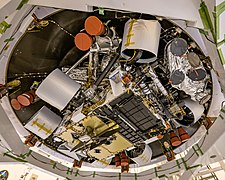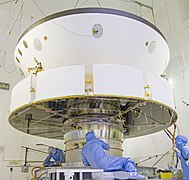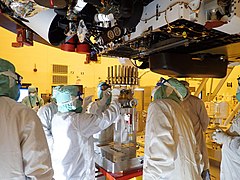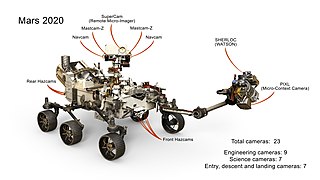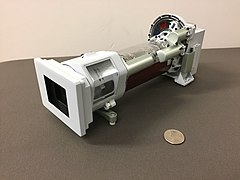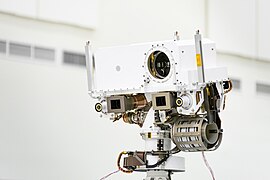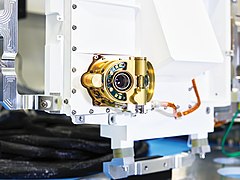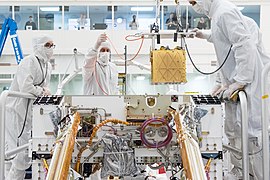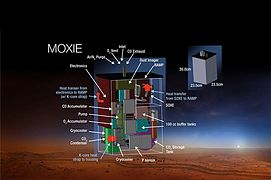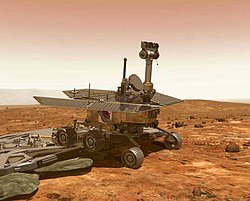Mars 2020
| Mars 2020 | ||||||||||||||||||||||
|---|---|---|---|---|---|---|---|---|---|---|---|---|---|---|---|---|---|---|---|---|---|---|
| Phase: E / Status: aktiv | ||||||||||||||||||||||
 Selfie des Rover Perseverance mit Helikopterdrohne Ingenuity (nahe der Van Zyl-Erhebung am 7. April 2021) | ||||||||||||||||||||||
| Typ | Raumsonde (Rover) | |||||||||||||||||||||
| Land | ||||||||||||||||||||||
| Organisation | Jet Propulsion Laboratory | |||||||||||||||||||||
| COSPAR-Bezeichnung | 2020-052A | |||||||||||||||||||||
| Missionsdaten | ||||||||||||||||||||||
| Startdatum | 30. Juli 2020, 11:50 UTC[1][2] | |||||||||||||||||||||
| Startplatz | Cape Canaveral AFS, SLC-41 | |||||||||||||||||||||
| Trägerrakete | Atlas V (541) (AV-088) | |||||||||||||||||||||
| Landeplatz | Jezero-Krater | |||||||||||||||||||||
| Allgemeine Raumfahrzeugdaten | ||||||||||||||||||||||
| Startmasse | 3839 kg | |||||||||||||||||||||
| Leermasse | 899 kg (Masse des Rovers) | |||||||||||||||||||||
| Nutzlastdaten | ||||||||||||||||||||||
| Instrumente | PIXL, RIMFAX, MEDA, MOXIE, SuperCam, Mastcam-Z, SHERLOC | |||||||||||||||||||||
| Sonstiges | ||||||||||||||||||||||
| Vorherige Mission | Mars Science Laboratory | |||||||||||||||||||||
| ||||||||||||||||||||||
Mars 2020 ist die fünfte Mars-Rover- und erste Helikopter-Mission der NASA auf dem Mars. Mittels einer Atlas-V-Trägerrakete wurde am 30. Juli 2020 vom Cape Canaveral eine Landesonde mit dem Rover Perseverance (deutsch „Ausdauer“, „Beharrlichkeit“) mit seinem Kleinhelikopter Ingenuity („Einfallsreichtum“) auf den 480 Millionen Kilometer langen Flug zum Mars gestartet. Die Sonde landete am 18. Februar 2021 auf der nördlichen Marshalbkugel im Jezero-Krater,[3] womit sie seit 1356 Sol aktiv ist.
Missionsziele, -planung und -ablauf bis zum Start
Die Mission ist Teil des Mars Exploration Program der NASA. Perseverance soll Marsgestein im Hinblick auf Biosignaturen, geologische Prozesse und die geologische Geschichte des Planeten genauer untersuchen, um so unter anderem Erkenntnisse über etwaiges Leben auf dem Mars zu gewinnen.[4][5] Außerdem soll der 2,5 Milliarden US-Dollar teure Rover das Klima auf dem Planeten untersuchen.[2] Die Mission dient auch der Vorbereitung eines bemannten Marsflugs. So wird der Rover testweise Kohlenstoffdioxid in Sauerstoff umwandeln und diese Ergebnisse analysieren.[6] Mars 2020 wurde am 4. Dezember 2012 während des Herbsttreffens der American Geophysical Union in San Francisco angekündigt. In einem offenen Wettbewerb wurden wissenschaftliche Instrumente für den Rover ausgesucht, nachdem die Missionsziele bekannt gegeben worden waren. Nachdem über 60 Vorschläge eingegangen waren, kündigte die NASA im Juli 2014 die Landung des Rovers an, der ähnlich wie der Curiosity-Rover konstruiert werden sollte.
Als Landeplatz wurde ein 3,5 Milliarden Jahre altes ehemaliges Flussdelta im Jezero-Krater gewählt,[7][8] das in der Syrtis Major Planitia (18° 51′ 18″ N, 77° 31′ 8,4″ O) liegt und vor etwa 3,9 bis 3,5 Milliarden Jahren ein 250 Meter tiefer See war.[5] Als Alternativen waren alte hydrothermale Quellen im Nordosten der Hochebene Syrtis Major und bei den Columbia Hills in Betracht gezogen worden.[9]
Damit die Perseverance so keimfrei wie möglich zum Mars gelangt – andernfalls könnte der Rover auf dem Mars Spuren von Leben nachweisen, das er selbst dorthin gebracht hat –, wurde die Montage der Perseverance in einem Reinraum im Inneren eines weiteren Reinraums am Jet Propulsion Laboratory vorgenommen.[10]
Als Trägerrakete für den Start der Raumsonde wurde die Atlas V 541 gewählt. Die Rakete ist 58 Meter hoch und besteht neben der Erststufe aus vier Feststoff-Boostern und einer Centaur-Oberstufe.[11] Das Startfenster für die Mission wurde nach einer Verschiebung auf den Zeitraum vom 30. Juli bis zum 15. August 2020 festgelegt; Startplatz war die Startrampe 41 der Cape Canaveral Air Force Station in Florida.[12]
- Planungsverlauf – Mars 2020
- Raumkapsel Mars 2020 a
- Landungsgebiet: Flussdelta im Jezerokrater
Aufbau und Technik der Raumsonde gegenüber der Marsmission MSL
Der Aufbau der Raumsonde und die Technik der Marschflug- und Landesysteme der Mars 2020 unterscheiden sich vor allem hinsichtlich der unterschiedlichen Rover und der weiterentwickelten Abstiegsstufe bedeutend von der der Marsmission Mars Science Laboratory (MSL).
Die Leit- und Steuerungstechnik der Mars 2020 konnte gegenüber der Marsmission MSL dahingehend verbessert werden, dass zum einen die Landestufe der Mars 2020 um die Funktion ergänzt wurde, Hindernissen auszuweichen[13][14] und zum anderen die Abweichung der Eigenlokalisierung der Abstiegsstufe von 3000 Meter auf 40 Meter reduziert wurde.[15]
Missionsfortschritt
Flug zum Mars
Am Tag der Landung auf dem Mars hatte die Sonde bezogen auf die Sonne einen Weg von 470 Millionen Kilometern zurückgelegt.[16] Die Distanz zwischen Erde und Mars schwankt zwischen 56 Millionen Kilometern und 401 Millionen Kilometern.[17] Die Sonde legte eine größere Distanz zurück als die maximale Entfernung zwischen Erde und dem langsamer umlaufenden Mars – das Startfenster ist ein Kompromiss zwischen Flugzeit und Antriebsenergie. Etwa 20 Stunden vor der Landung lag die Reisegeschwindigkeit (relativ zur Sonne) der Sonde bei etwa 76.820 Kilometer pro Stunde.[16]
Landung auf dem Mars
Der Anflug und die Landung am 18. Februar 2021 erfolgten aufgrund der Signallaufzeit von etwa 11 Minuten zwischen Erde und Mars wie bei vorhergehenden Missionen vollautomatisch; die Instruktionen hierzu wurden der Sonde und dem Rover einprogrammiert. Die Abstiegsstufe war in der Lage, Hindernisse zu erkennen und ggf. den Landeplatz mit Seitwärtsbewegungen um bis zu 300 Meter zu ändern.[13][14]
Während und nach der Landung, die um 20:55 Uhr (UTC) im Mission Control Center des JPL bestätigt wurde, überflog die Raumsonde Mars Reconnaissance Orbiter, die über das Deep Space Network mit der Erde verbunden ist, die Landestelle und diente als Relaisstation. Wenige Stunden nach der Landung überflog der Exomars Trace Gas Orbiter die Landestelle und übernahm die Rolle als Relaisstation.[18] Die Raumsonde Maven veränderte ihrerseits vor der Landung der Mars 2020 ihren Kurs, um den Vorgang mit ihren Instrumenten zu dokumentieren.[19] Die Mars Express überwacht im Zuge der Mission die lokalen Wetterbedingungen.[18]
Wichtige Missionsetappen
- Am 22. Februar 2021 wurden erstmals Tonaufnahmen vom Mars veröffentlicht.[20]
- Am 19. April 2021 flog die Helikopterdrohne Ingenuity für 39 Sekunden erstmals auf dem Mars und erreichte dabei eine Flughöhe von 3 Metern.[21][22] Damit flog erstmals[23] ein Helikopter auf einem fremden Himmelskörper.[22]
- Am 20. April 2021 wurde erstmals in der Geschichte der Raumfahrt auf einem fremden Planeten Sauerstoff gewonnen. Das Instrument MOXIE stellte bei diesem ersten Test auf dem Mars innerhalb einer Stunde 5,4 Gramm Sauerstoff aus Kohlenstoffdioxid her.[24] Ein Astronaut könnte hiermit für zehn Minuten atmen.[25]
- Am 1. September 2021 gelang die erste Gesteinsprobenaufnahme der Perseverance nach zuvor erfolgter Gesteinsbohrung.[26]
Instrumente der Perseverance
(Dauer: 2:20 Min)
Neben 23 Kameras ist der Rover auch mit zwei Mikrofonen ausgestattet, mit denen erstmals Töne vom Mars übertragen werden konnten. Zwar hatten bereits zwei vorhergehende NASA-Missionen Schallwandler an Bord, jedoch scheiterte die Landung von Mars Polar Lander, und das in der Kamera des Abstiegsmoduls von Phoenix eingebaute Mikrofon wurde nie aktiviert.[27] Bei der Perseverance wurde dagegen das Mikrofon in Betrieb genommen. Die Perseverance nahm sowohl Windgeräusche des Planeten, als auch die der Helikopterdrohne auf – und ist damit die erste Maschine außerhalb der Erde, die Töne einer anderen Maschine außerhalb der Erde aufgenommen hat.[28][29]
Mastcam-Z
Mastcam-Z ist ein panoramisches und stereoskopisches Kamerasystem mit Zoomobjektiv. Das Instrument soll außerdem die Minerale auf der Oberfläche des Mars bestimmen und bei der Navigation helfen. Das Instrument wurde von der Gruppe um James Bell an der Arizona State University in Tempe entwickelt.[30] Gebaut wurde es unter anderem vom Malin Space Science Systems in San Diego, Kalifornien. Neben anderen US-amerikanischen Universitäten war bzw. ist auch das Deutsche Zentrum für Luft- und Raumfahrt und die österreichische Joanneum Research GmbH an dem Projekt beteiligt.[31]
SuperCam
SuperCam ist ein Zusammenbau von vier Spektrometern, die per laserinduzierter Plasmaspektroskopie Analysen von Gesteinen und Böden durchführen sollen. Mit der Supercam kann nach organischen Verbindungen in Steinen und Regolithen gesucht werden. Sie wurde entwickelt, um Biosignaturen von Mikroben auf dem Mars zu identifizieren.[32]
Hauptsächlich wurde das Instrument von einem Team des Los Alamos National Laboratory, in Los Alamos, New Mexico, entwickelt. Beigetragen haben aber auch die französische Raumfahrtagentur (L’Institut de Recherche en Astrophysique et Planétologie [CNES/IRAP]) sowie Forschungseinrichtungen der Universitäten von Hawaii und der spanischen Universität Valladolid.[33]
Planetary Instrument for X-ray Lithochemistry (PIXL)
Das Planetary Instrument for X-ray Lithochemistry (PIXL) ist ein Röntgenstrahlen-Fluoreszenzspektroskop, das auch mit einer hochauflösenden Kamera ausgestattet ist und die elementare Zusammensetzung der Marsoberfläche bestimmen soll. PIXL wurde von dem Team um Abigail Allwood, NASA Jet Propulsion Laboratory (JPL) in Pasadena, Kalifornien, entwickelt.[34][35]
Scanning Habitable Environments with Raman & Luminescence for Organics and Chemicals (SHERLOC)
Scanning Habitable Environments with Raman & Luminescence for Organics and Chemicals (SHERLOC) ist ein Spektrometer, das mit Ultraviolett-Lasern die genaue Mineralogie und organische Verbindungen bestimmen soll. SHERLOC ist das erste Ultraviolett-Raman-Spektrometer, das zum Mars flog. Es wurde von dem Team um Luther Beegle, NASA Jet Propulsion Laboratory (JPL) in Pasadena, Kalifornien, verwirklicht.[36][37]
The Mars Oxygen ISRU Experiment (MOXIE)
The Mars Oxygen ISRU Experiment (MOXIE) ist ein Instrument zur Erforschung einer Technologie, die das in der Marsatmosphäre vorhandene Kohlenstoffdioxid elektrochemisch in Sauerstoff und Kohlenmonoxid umwandelt. Der gewonnene Sauerstoff soll nach einer Analyse seiner Reinheit wieder mit dem Kohlenmonoxid in die Marsatmosphäre abgegeben werden. MOXIE wurde von einem Team des Massachusetts Institute of Technology in Cambridge, Massachusetts, entworfen.[38]
Mars Environmental Dynamics Analyzer (MEDA)
Der Mars Environmental Dynamics Analyzer (MEDA) besteht aus einer Reihe von Sensoren, die für die Aufzeichnung von optischen Eigenschaften von Staub und sechs atmosphärischen Parametern entwickelt wurden. Die Abkürzung MEDA steht gleichzeitig für ¡me da! (spanisch für „Gib mir!“), im Sinne von: „Gib mir Informationen über Wetter, Staub, Strahlung!“[39] Die Instrumente wurden von einem Team des spanischen Instituto Nacional de Técnica Aeroespacial entworfen.[40]
Auf dem Mars soll MEDA die Größe und Menge der Staubpartikel sowie Windrichtung, Windgeschwindigkeit, Luftdruck, relative Luftfeuchtigkeit, Lufttemperatur, Bodentemperatur, bestimmte Bandbreiten von ultravioletter Strahlung, sichtbare Strahlung und Infrarotstrahlung messen. Die zu MEDA gehörenden Sensoren befinden sich auf der Oberseite und Front des Rovers, ebenso auf der oberen Rückseite des Remote Sensing Mast und in seinem Innenraum. Sie haben ein Gesamtgewicht von 5,5 Kilogramm.[39][41]
Die Sensoren des MEDA

- RDS – radiation and dust sensor (Sensor für Strahlung und Staub): Abmessungen: 13,2 cm × 11,5 cm × 12,5 cm; auf der Oberseite des Rovers, bestehend aus acht nach oben ausgerichteten Fotodioden
- HS – humidity sensor (Sensor für relative Luftfeuchtigkeit): Abmessungen: 5,5 cm × 2,5 cm × 7,25 cm; auf dem Remote Sensing Mast innerhalb eines Schutzzylinders und von einem Staubfilter umgeben angebracht
- TIRS – thermal infrared sensor (Infrarotsensor): Abmessungen: 6,25 cm × 5,25 cm × 5,75 cm; am Remote Sensing Mast angebracht auf die vordere rechte Seite des Rovers ausgerichtet; bestehend aus drei aufwärtsgerichteten und zwei abwärtsgerichteten Thermosäulen
- ATS1–ATS5 – air temperature sensor 1–5 (Lufttemperatursensoren 1–5): Abmessungen: 5,75 cm × 2,75 cm × 6,75 cm; drei um den Remote Sensing Mast, zwei weitere am Hauptteil des Rovers angebracht
- WS1–WS2 – wind sensor 1–2 (Windsensoren 1–2): Abmessungen: Windsensor 1: 5 cm × 17 cm und Windsensor 2: 25 cm × 40 cm; am Remote Sensing Mast angebracht
- PS – pressure sensor (Drucksensor und Kontrolleinheit): Abmessungen: 14 cm × 14 cm × 13 cm; im Inneren des Rovers mit einer nach außen führenden Röhre montiert[39][41]
The Radar Imager for Mars’ Subsurface Exploration (RIMFAX)
The Radar Imager for Mars’ Subsurface Exploration (RIMFAX) ist ein Bodenradar, das alle 10 cm Fahrtstrecke ein Vertikalprofil gewinnt und so während der Fahrt ein zweidimensionales Bild des Untergrundes je nach Beschaffenheit bis über 10 m Tiefe liefert. Es analysiert anhand der reflektierten und gestreuten Funkwellen die geologische Struktur und Dichte des Bodens, um im und unter dem Sediment u. a. Gesteine, Meteoriten oder Wassereis und Sole erkennen zu können – das Landegebiet ist ein Einschlagkrater, der nachfolgend von Wasser überformt und von Sediment bedeckt ist. Das Gerät arbeitet mit Funkwellen zwischen 120 und 1200 MHz, um je nach Bodenbeschaffenheit eine hohe Eindringtiefe bei niedrigen Frequenzen und eine hohe vertikale Auflösung bei hohen Frequenzen zu haben. Das Instrument wurde von Norwegens Verteidigungsforschungsinstitut (Forsvarets forskningsinstitutt) um Svein-Erik Hamran entwickelt. RIMFAX ist das erste direkt auf dem Mars arbeitende Bodenradar und kann detailliertere Daten liefern als dies bisher vom Marssatelliten aus möglich war. Der Name geht auf Hrímfaxi, ein Pferd der nordischen Mythologie, zurück.[42][43][44]
Helikopterdrohne
Einsatz


Im Rahmen der Mars-2020-Mission wurde erstmals eine Helikopterdrohne auf einem anderen Himmelskörper eingesetzt, der Mars Helicopter,[45][46] auch Ingenuity (englisch für Einfallsreichtum, Erfindungsgabe) genannt.[47] Außer Kameras trug Ingenuity keine Gerätschaften.[48] Die Drohne sollte vor allem als Testmodell für zukünftige Flugobjekte auf dem Mars dienen,[49] Nach NASA-Angaben war er als Technologie-Demonstrator für fünf Flüge ausgelegt.[50]
Beim erfolgreichen Erstflug am 19. April 2021 erreichte Ingenuity die vorgesehene Flughöhe von 3 m und hielt diese für 39 s.[21][51] Nach dem Abschluss der geplanten fünf Testflüge wurde Ingenuity mehrere Jahre lang dazu genutzt, um die Fahrtroute des Rovers auszukundschaften.[52]
Die Navigation des Helikopters wurde auf hügeligem Gelände ungenau, da in den Bordcomputer eine für flaches Gelände ausgelegte Navigation fest einprogrammiert war. Die zu erwartenden Schwierigkeiten wurden anhand von Simulationen bei der Planung der Flugrouten mit berücksichtigt.[53]
Am 14. April 2023 absolvierte die Drohne ihren 50. Flug.[54] Am 25. Januar 2024 gab die NASA das Ende der Ingenuity-Mission bekannt, nachdem der Helikopter sechs Tage zuvor beim 72. Flug beim Landen einen Rotorschaden erlitten hatte.[52]
Technik
Ingenuity wurde sowohl aus eigens entwickelten als auch aus Off-the-shelf-Komponenten gebaut und mit sechs aus Solarzellen geladenen Akkumulatoren betrieben. Seine Masse beträgt 1,8 Kilogramm, was auf der Erde eine Gewichtskraft von 18 Newton ergibt. Auf dem Mars beträgt die Gewichtskraft nur 6,8 Newton.[55] Dass auf der Marsoberfläche nur etwa ein Drittel der Schwerkraft der Erde auf den Helikopter wirkt, erleichterte den Aufstieg. Die im Vergleich zur Erdatmosphäre etwa nur ein Hundertstel so dichte Gasatmosphäre des Mars erschwert dagegen das Erzeugen von Auftrieb durch die Rotoren des Helikopters. Um abheben zu können, verfügte der Helikopter über zwei koaxial montierte Rotoren. Diese bestanden aus je zwei CFK-Rotorblättern von 1,2 m Durchmesser und rotierten gegenläufig mit vom Atmosphärendruck abhängiger, variabler Drehzahl von etwa 2400 Umdrehungen bis zu maximal 2700 Umdrehungen pro Minute.[56][57]
Die Lithium-Ionen-Akkus wurden im August 2020 während des Flugs zum Mars in einem acht Stunden dauernden Vorgang überprüft und vollgeladen. Der vorher niedrige Ladezustand von 35 % sollte in Anbetracht der langen Flugzeit eine optimale Lebensdauer der Akkus sicherstellen.[58]
Die Flugroute bzw. die Steuerungsbefehle (Algorithmen) erhielt die Helikopterdrohne vor dem Flug. Die Übermittlung der Steuerbefehle zum Mars dauerte etwa acht Minuten.[59] Die Orientierung und Navigation während des Flugs des Helikopters funktionierte autonom, da die Signallaufzeit zur Erde zu lang war. Dazu wurden Kamera, Laserhöhenmesser[60] und Trägheitssensoren verwendet.[51] Die Steuersoftware ist Open Source[61] und das Betriebssystem der Drohne war Linux.[62] Die Kommunikation mit dem Rover erfolgte über das ZigBee-Protokoll.[63]
Als Hommage an den ersten Motorflug des Wright Flyer auf der Erde hatten Wissenschaftler des NASA Jet Propulsion Laboratory an der Mars-Drohne an einem Kabel unter einem ihrer Sonnenkollektoren ein kleines Stück der Stoffbespannung einer Tragfläche des Original-Flugzeugs der Gebrüder Wright von 1903 befestigt. Es war das zweite Stück des Wright Flyers, das in den Weltraum flog. Ein ähnliches Mini-Stück vom Flügel wurde während der Apollo-Missionen zum Mond gebracht.[64]
Mögliche Nachfolgemissionen

Es gibt Pläne, das vom Rover gewonnene Marsgestein mit einer darauf folgenden Mars-Sample-Return-Mission zur Erde zu bringen. Dazu sollen mehrere etwa 15 g schwere Gesteinsproben in Behältern hermetisch versiegelt werden (43 Behälter sind an Bord). Diese sollen dann im Rover gesammelt und an dafür günstigen Orten auf der Marsoberfläche abgelegt werden. So sind die Probenbehälter auch im Falle eines Ausfalls des Rovers für die spätere Abholung weiter zugänglich. Bei nachfolgenden Missionen könnten sie zur Erde zurückgebracht werden.[65]
Da der Rover auch Methoden zur Gewinnung von Sauerstoff aus der Marsatmosphäre prüft, nach anderen Ressourcen (z. B. unterirdischem Wasser) sucht sowie Umweltbedingungen wie Wetter und Staub untersucht, ist die Mission Bestandteil der Vorbereitung für einen bemannten Marsflug.[4]
Außerdem wird erwogen, in Zukunft eine größere, mit mehreren wissenschaftlichen Instrumenten ausgestattete Helikopterdrohne zum Mars zu schicken, den Mars Science Helicopter.[66]
Trivia
- Am rückwärtigen Bereich von Perseverance wurde eine Aluminiumplatte montiert, mit einer Abbildung, auf der Erde und Mars durch Strahlen der Sonne verbunden sind. In den Sonnenstrahlen stehen in Morsezeichen die Worte „explore as one“ (zu deutsch: „Erkunde als Einheit“), eine Anspielung auf die Pioneer-Plaketten und Voyager Golden Records. Über dieser Gravur befinden sich drei fingernagelgroße Siliziumchips und rechts davon eine eckige Klammer mit „10,932,295 Explorers“. Die NASA ermöglichte im Rahmen einer „Send Your Name to Mars“-Kampagne (wie bei Curiosity zuvor), dass interessierte Personen ihren Namen darauf verewigen lassen konnten. Insgesamt wurden während des Registrierungszeitraums 10.932.295 Namen eingereicht und mittels Elektronenstrahl eingraviert. Ferner gelangten auch 155 Essays, die es ins Finale des „Name the Rover“-Wettbewerbs schafften, auf die Mikrochips.[67]
- Der Fallschirm der Abstiegsstufe war wie üblich rot-weiß gestreift, um leichter zu erkennen, ob er sich vollständig entfaltet hat und nicht verdreht ist. Bei Mars 2020 sind die Streifen allerdings unregelmäßig angeordnet. Dies wurde als versteckter Binärcode definiert und entschlüsselt – die roten Streifen entsprechen der „1“ und die weißen der „0“. Unter Verwendung des ASCII-Codes lassen sich aus den drei inneren Ringen die Worte „dare mighty things“ (zu deutsch: „Große Dinge wagen“), das Motto des Jet Propulsion Laboratory (JPL), interpretieren. Der äußere vierte Ring ergibt die Geokoordinaten des JPL in La Cañada Flintridge (34° 11′ 58″ N, 118° 10′ 31″ W).[68][69]
- Auf der linken Seite von Perseverance befindet sich eine 8 cm × 13 cm große Aluminiumplatte mit einem Äskulapstab drauf, der die Erde hält. Die NASA würdigt damit die Mitarbeiter im Gesundheitswesen und ihre Arbeit während der Corona-Pandemie.[70]
- Auf der Oberseite von Perseverance befindet sich ein „Familienporträt“ aller vorherigen Marsrover (Sojourner, Spirit, Opportunity, Curiosity) sowie Perseverance und Ingenuity selbst.[71]
- Zur Kalibrierung der WATSON-Kamera dient auch eine Münze aus Polycarbonat. Darauf steht die Adresse des berühmten Detektivs: „221bBaker“. Die Münze ist zugleich eine Geocoin für Geocacher.[72]
- An einem Draht befestigt trägt der Mars-Helikopter ein kleines Stück Stoff vom Flugzeug der Gebrüder Wright, die 1903 den ersten Motorflug auf der Erde schafften.[73][74]
- Einen Tag vor der Landung auf dem Mars wurde im Hubschraubermuseum Bückeburg ein Modell der Ingenuity im Maßstab 1:1 der Öffentlichkeit vorgestellt.[75]
- Plakette mit den drei Mikrochips, auf denen die Personennamen und Essays eingraviert sind
- Der entfaltete Fallschirm während der Landung
- Plakette mit Verweis auf die Corona-Pandemie
- Das „Familienporträt“ der Marsrover
Galerie
- Rover
- Zusammenbau Raumsonde – Details
- Marschflug-Modul – Zusammenbau 1
- Abstiegsstufe – Zur Landung auf der Marsoberfläche 2
- Abstiegsstufe – Zur Prüfung des Vehikelschwerpunkts 3
- Abstiegsstufe – Blick von oben 4
- Hitzeschild von oben betrachtet
- Blick unter das Marschflug-Modul
- Blick von unten auf die Raumsonde 5
- Umgedrehtes Marschflug-Modul 6
- Instrumente des Rovers – Details
- Instrumente des Rovers (künstlerische Darstellung, englisch) 7
- Kühlsystem der Radionuklidbatterie (MMRTG) – Mitte-rechts 8
- Radionuklidbatterie (MMRTG) des Mars 2020
- Innere Verkabelung und Kabel des Rovers – Fahrzeugunterseite
- Probenröhrchen bei der Montage mit dem Rover
- 23 Kameras des Rovers (künstlerische Darstellung, englisch) 9
- Einbau des MOXIE – Mars Oxygen ISRU Experiment – in den Mars Rover
- Aufbau des MOXIE (künstlerische Darstellung, englisch)
- Anmerkungen
Siehe auch
Dokumentation
- Perseverance – Ein Jahr auf dem Mars. Regie: Alain Tixier, ARTE F, Frankreich, 53 Minuten, 2022
Weblinks
- NASA-Website zur Mars-2020-Mission (englisch)
- NASA-Bildarchiv: Kamerarohdaten von Perserverance Rover und Ingenuity Helikopter
- Bildarchiv der Arizona State University: Aufnahmen der Mastcam-Z in zwei unterschiedlichen Kalibrierungen
- Bildarchiv: Farbkalibrierte Aufnahmen von Ingenuity Helikopter und Perseverance Rover Navcam, Hazcam, Watson-Kameras in Ultra HDR
Einzelnachweise
- ↑ Launch – Mars 2020 Mission, Perseverance Rover Launch. mars.nasa.gov, abgerufen am 5. Juli 2020 (englisch).
- ↑ a b pgo/dpa: Nasa gibt grünes Licht für Start des Marsrover „Perseverance“. DER SPIEGEL – Wissenschaft, 27. Juli 2020, abgerufen am 27. Juli 2020.
- ↑ NASA Television Upcoming Events. Watch NASA TV. In: nasa.gov. 22. Februar 2020, abgerufen am 22. Februar 2021 (englisch, NASA-TV-Programm).
- ↑ a b Mars 2020 Mission Overview. In: mars.nasa.gov. NASA, abgerufen am 2. August 2019 (englisch).
- ↑ a b Mike Wall: Jezero Crater or Bust! NASA Picks Landing Site for Mars 2020 Rover. In: www.space.com. 18. November 2018, abgerufen am 18. Februar 2021 (englisch).
- ↑ Touchdown! NASA’s Mars Perseverance Rover Safely Lands on Red Planet. In: mars.nasa.gov. 18. Februar 2021, abgerufen am 20. Februar 2021 (englisch).
- ↑ NASA Announces Landing Site for Mars 2020 Rover. In: NASA. 19. November 2018, abgerufen am 20. November 2018 (englisch).
- ↑ PIA19303: A Possible Landing Site for the 2020 Mission: Jezero Crater. In: photojournal.jpl.nasa.gov. National Aeronautics and Space Administration – NASA, abgerufen am 29. Mai 2016 (englisch).
- ↑ Landeplätze für neuen Marsrover ausgewählt. In: scinexx.de. 14. Februar 2017, abgerufen am 14. Februar 2017 (Quelle: NASA, 14. Februar 2017 – NPO).
- ↑ Christoph Seidler: Suche nach Lebensspuren auf dem Mars – Das kann der Nasa-Rover »Perseverance«. In: DER SPIEGEL. Abgerufen am 18. Februar 2021.
- ↑ Launch Vehicle – Mars 2020 Rover. In: mars.nasa.gov. Abgerufen am 21. Mai 2017 (englisch).
- ↑ Stephen Clark: Spaceflight Now – NASA delays Mars rover launch to no earlier than July 30. In: spaceflightnow.com. Abgerufen am 1. Juli 2020 (amerikanisches Englisch).
- ↑ a b Mars-Rover Perseverance: Landung geglückt. In: spektrum.de. Abgerufen am 19. Februar 2021.
- ↑ a b Dc Agle, Jet Propulsion Laboratory: Landing the Mars 2020 rover: Autopilot will avoid terrain hazards autonomously. In: phys.org. 2. Juli 2019, abgerufen am 19. Februar 2021 (englisch).
- ↑ Eric Berger: Here’s an example of the crazy lengths NASA goes to land safely on Mars. In: arstechnica.com. 7. Oktober 2019, abgerufen am 19. Februar 2021 (amerikanisches Englisch).
- ↑ a b Mars 2020 Perseverance Rover. In: mars.nasa.gov. Abgerufen am 18. Februar 2021 (englisch).
- ↑ WAS IST WAS – Wie weit ist der Mars von der Erde entfernt? In: wasistwas.de. Tessloff Verlag, abgerufen am 18. Februar 2021.
- ↑ a b Tanja Banner: „MARS 2020“-MISSION – Mars-Rover „Perseverance“ schickt spektakuläres 360-Grad-Panorama zur Erde. In: fr.de. 25. Februar 2021, abgerufen am 26. Februar 2021.
- ↑ Lonnie Shekhtman: NASA’s MAVEN Shrinking Its Orbit for Mars 2020 Rover. In: jpl.nasa.gov. Jet Propulsion Laboratory, Caltech, abgerufen am 19. Februar 2021 (englisch).
- ↑ NASA’s Mars Perseverance Rover Provides Front-Row Seat to Landing, First Audio Recording of Red Planet. In: jpl.nasa.gov. Jet Propulsion Laboratory, Caltech, 22. Februar 2021, abgerufen am 23. Februar 2021 (englisch).
- ↑ a b Alexandra Witze: Lift off! First flight on Mars launches new way to explore worlds. In: Nature. 19. April 2021, doi:10.1038/d41586-021-00909-z (nature.com [abgerufen am 20. April 2021]).
- ↑ a b Christoph Seidler: Erster Flug ist geglückt: Mars-Helikopter Ingenuity erfolgreich abgehoben. In: Der Spiegel. Abgerufen am 19. April 2021.
- ↑ Anm.: Erstmals wurde damit ein (menschengemachter) aerodynamisch erzeugter Auftrieb zum Aufsteigen eines Flugkörpers außerhalb der Erde genutzt. Eine aerodynamische Bremswirkung ist außerhalb der Erde, ebenfalls am Mars, zuvor jedoch schon genutzt worden.
- ↑ NASA’s Perseverance Mars Rover Extracts First Oxygen From Red Planet. In: mars.nasa.gov. Abgerufen am 22. April 2021 (englisch).
- ↑ Pressebericht Tagesschau vom 22. April 2021.
- ↑ Tony Greicius: NASA’s Perseverance Rover Successfully Cores Its First Rock. In: NASA.gov. 2. September 2021, abgerufen am 5. September 2021.
- ↑ Microphones – Microphones on the Perseverance Rover. In: mars.nasa.gov. Abgerufen am 3. Dezember 2019 (englisch).
- ↑ mars.nasa.gov: Hear Sounds From Mars Captured by NASA’s Perseverance Rover. Abgerufen am 20. Oktober 2021 (englisch).
- ↑ Janita Hämäläinen: Nasa-Rover »Perseverance«: So klingen die Sounds vom Mars. In: Der Spiegel. 20. Oktober 2021, ISSN 2195-1349 (spiegel.de [abgerufen am 20. Oktober 2021]).
- ↑ NASA Announces Mars 2020 Rover Payload to Explore the Red Planet as Never Before | Mars News. In: mars.nasa.gov. Abgerufen am 20. Mai 2017 (englisch).
- ↑ Mast-Mounted Camera System – Mastcam-Z. In: mars.nasa.gov. Abgerufen am 18. Juni 2020 (englisch): „Think of Mastcam-Z as the Perseverance rover’s main „eyes.“ It is located near the top of the rover’s mast (its „head“). It’s a camera system, and it has a Zoom capability – Z for the mark of zoom! What would you call it but Mastcam-Z?“
- ↑ SuperCam. In: mars.nasa.gov. Abgerufen am 9. April 2021 (englisch).
- ↑ Karen Northon: NASA Signs Agreements to Advance Journey to Mars. In: nasa.gov. 16. Juni 2015, abgerufen am 19. Juni 2020 (englisch).
- ↑ Mars 2020 Rover’s PIXL to Focus X-Rays on Tiny Targets. In: jpl.nasa.gov. Jet Propulsion Laboratory – JPL, abgerufen am 19. Juni 2020 (englisch).
- ↑ David R. Thompson, Abigail Allwood, Christopher Assad, David Flannery, Robert Hodyss, Emily Knowles, Lawrence Wade:Adaptive sampling for rover x-ray lithochemistry. ( vom 8. August 2014 im Internet Archive). PDF; 3,2 MB. In: davidraythompson.com, abgerufen am 19. Juni 2020 (englisch).
- ↑ SHERLOC to Micro-Map Mars Minerals and Carbon Rings. In: jpl.nasa.gov. Jet Propulsion Laboratory, abgerufen am 19. Juni 2020 (englisch).
- ↑ 11thInternationalGeoRamanConference(2014). (PDF; 320 kB) In: hou.usra.edu. Universities Space Research Association – USRA Houston, abgerufen am 20. Juni 2020 (englisch).
- ↑ NASA TechPort. In: techport.nasa.gov. NASA, abgerufen am 19. Juni 2020 (englisch).
- ↑ a b c Mars Environmental Dynamics Analyzer (MEDA). In: mars.nasa.gov. Abgerufen am 18. August 2020 (englisch).
- ↑ Space Technology: Game Changing Development | In-Situ Resource Utilization (ISRU). NASA, 2. April 2015, archiviert vom (nicht mehr online verfügbar) am 2. April 2015; abgerufen am 12. Dezember 2022 (englisch).
- ↑ a b MEDA for Scientists (Mars Environmental Dynamics Analyzer). In: mars.nasa.gov. Abgerufen am 18. August 2020 (englisch).
- ↑ Emily Chung: Mars 2020 rover’s RIMFAX radar will ‘see’ deep underground. In: cbc.ca. 19. August 2014, abgerufen am 20. Juni 2020 (englisch).
- ↑ Radar Imager for Mars’ Subsurface Exploration (RIMFAX). In: mars.nasa.gov. Abgerufen am 19. Juni 2020 (englisch).
- ↑ NASA’s Perseverance Rover Will Peer Beneath Mars’ Surface. In: ffi.no. FFI (Forsvarets forskningsinstitutt) – Forschungsabteilung der norwegischen Streitkräfte, 13. Oktober 2020, abgerufen am 26. Februar 2021 (englisch, Mitteilung des Norwegischen Verteidigungsforschungsinstitutes vom 13. Oktober 2020): „This article was first published on Nasa’s web-page on October 8. 2020.“
- ↑ Norbert Lossau: Dieser Hubschrauber soll über dem Mars fliegen. In: welt.de. 21. April 2020, abgerufen am 21. April 2020.
- ↑ Mars Helicopter – Quick Facts. In: mars.nasa.gov. Abgerufen am 23. April 2020 (englisch).
- ↑ Alabama High School Student Names NASA’s Mars Helicopter. In: mars.nasa.gov. 29. April 2020, abgerufen am 29. April 2020 (englisch): „Vaneeza Rupani’s essay was chosen as the name for the small spacecraft, which will mark NASA’s first attempt at powered flight on another planet.“
- ↑ Karen Northon: Mars Helicopter to Fly on NASA’s Next Red Planet Rover Mission. In: www.nasa.gov. 11. Mai 2018, abgerufen am 30. April 2019 (englisch).
- ↑ Jonathan Amos: Nasa prepares tiny chopper for Mars flight. In: BBC News. 29. August 2019 (englisch, bbc.com [abgerufen am 19. Juni 2020]).
- ↑ NASA’s Ingenuity Mars Helicopter Completes 50th Flight auf Jet Propulsion Laboratory
- ↑ a b Meet Ingenuity: The high-tech helicopter designed to fly on Mars. Abgerufen am 20. April 2021.
- ↑ a b After Three Years on Mars, NASA’s Ingenuity Helicopter Mission Ends. Pressemeldung des JPL vom 25. Januar 2024.
- ↑ Alexander Stirn: Ingenuity fliegt und fliegt und fliegt. In: spektrum.de. 19. April 2022, abgerufen am 24. April 2022.
- ↑ Karin Schlott: 50. Flug von Ingenuity: Totgesagte fliegen länger. In: spektrum.de. 14. April 2023, abgerufen am 14. April 2023.
- ↑ INGENUITY MARS HELICOPTER – Landing Press Kit. (PDF; 5,6 MB) In: jpl.nasa.gov. NASA, abgerufen am 26. Februar 2021 (englisch, Quick Facts, Seite 12).
- ↑ Ingenuity Mars Helicopter: Landing Press Kit. (PDF) In: jpl.nasa.gov. Januar 2020, abgerufen am 5. April 2021 (englisch).
- ↑ Ingenuity fliegt und fliegt und fliegt. In: spektrum.de. 19. April 2022, abgerufen am 12. Mai 2022.
- ↑ Tony Greicius: NASA’s Ingenuity Mars Helicopter Recharges Its Batteries in Flight. In: nasa.gov. 13. August 2020, abgerufen am 18. August 2020 (englisch).
- ↑ Christoph Seidler: Wie fliegt es sich auf dem Mars? Der Chefpilot des Nasa-Helikopters »Ingenuity« im Interview. In: Der Spiegel. Abgerufen am 9. Juni 2021.
- ↑ LIDAR-Lite v3. Typenblatt des verwendeten „LIDAR-Lite v3“ Optical Distance Measurement Sensor der Firma Garmin Ltd. / USA, abgerufen am 20. April 2021.
- ↑ A flight software and embedded systems framework. Abgerufen am 22. April 2021.
- ↑ Ingenuity: Linux hebt auf dem Mars ab. Abgerufen am 20. April 2021.
- ↑ Zigbee inside the Mars Perseverance Mission and your smart home. Abgerufen am 6. September 2021.
- ↑ Gail Iles: So a helicopter flew on Mars for the first time. A space physicist explains why that’s such a big deal. Artikel in space.com vom 22. April 2021, abgerufen am 22. April 2021.
- ↑ Surface Operations for Perseverance – MARS 2020 ROVER Depot Caching Strategy. In: mars.nasa.gov. Abgerufen am 3. Januar 2021 (englisch).
- ↑ Jeff Foust: NASA studying larger Mars helicopters. In: spacenews.com. 24. Juni 2021.
- ↑ Nearly 11 Million Names of Earthlings are on Mars Perseverance. NASA, 23. Februar 2021, abgerufen am 7. März 2021 (englisch).
- ↑ Kenneth Chang: NASA Sent a Secret Message to Mars. Meet the People Who Decoded It. In: New York Times. 26. Februar 2021, abgerufen am 6. März 2021 (englisch).
- ↑ Viola Ulrich: Diese verschlüsselten Botschaften verstecken sich am Mars-Rover. In: Welt online. 25. Februar 2020, abgerufen am 6. März 2021.
- ↑ Mike Wall: NASA’s next Mars rover carries tribute to healthcare workers fighting coronavirus. In: space.com. 17. Juni 2020, abgerufen am 6. März 2021 (englisch).
- ↑ Hanneke Weitering: NASA’s Perseverance rover on Mars is carrying an adorable ‘family portrait’ of Martian rovers. In: space.com. 25. Februar 2021, abgerufen am 6. März 2021 (englisch).
- ↑ Trackable TB5EFXK – Mars Perseverance Rover. In: Geocaching.com. 21. Juli 2020, abgerufen am 1. April 2021 (englisch).
- ↑ „Ingenuity“: Heli-Flug auf dem Mars: Countdown läuft. In: orf.at. 9. April 2021, abgerufen am 19. April 2021.
- ↑ Gebrüder-Wright-Moment: Erster Flug auf anderem Planeten geglückt. In: orf.at. 19. April 2021, abgerufen am 19. April 2021.
- ↑ Am 17. Februar 2021 im Hubschraubermuseum gelandet. Abgerufen am 24. Mai 2021.
- ↑ NASA’s Next Mars Rover Progresses Toward 2020 Launch. In: mars.nasa.gov. 15. Juli 2016, abgerufen am 10. Dezember 2022 (englisch).
Auf dieser Seite verwendete Medien
Icon für eine vertikale Zeitleiste
Icon für eine vertikale Zeitleiste
Icon für eine vertikale Zeitleiste
Autor/Urheber: Phoenix7777, Lizenz: CC BY-SA 4.0
Animation of Mars 2020's trajectory around Sun
▇ Mars 2020 · ▇ Sun · ▇ Earth · ▇ Mars
NASA Mars 2020 rover : MEDA-diagram
NASA Mars 2020 Rover Sample Collection Animation
February 06, 2020
https://mars.nasa.gov/resources/24757/nasa-mars-2020-rover-sample-collection-animation/
https://mars.nasa.gov/news/8611/nasa-adds-return-sample-scientists-to-mars-2020-leadership-team/
When NASA’s Mars 2020 rover lands on the Red Planet on Feb. 18, 2021, it will seek signs of past microbial life and characterize the planet’s climate and geology. It is the first rover ever to carry a drill for coring samples from Martian rocks and soil. This series of animations shows how those precious samples will be safely stowed on Mars for potential future pickup and return to Earth by another mission.
Mars 2020 is scheduled to launch in the summer of 2020.
For more information about the mission, visit: https://mars.nasa.gov/mars2020/NASA's 2020 Mars rover mission will go to a region of Mars thought to have offered favorable conditions long ago for microbial life, and the rover will search for signs of past life there. It will also collect and cache samples for potential return to Earth, for many types of laboratory analysis. As a pioneering step toward how humans on Mars will use the Red Planet's natural resources, the rover will do an experiment to extract oxygen from the Martian atmosphere.
This 2016 image comes from computer-assisted-design work on the 2020 rover. The design leverages many successful features of NASA's Curiosity rover, which landed on Mars in 2012, but it adds new science instruments and a sampling system to carry out the new goals for the mission.
Under the front right wheel of the rover (later named Perseverance) one may see the gray blades and the green, round-shaped (finally it got its rectangular design) solar panel of the Mars Helicopter Scout (later named Ingenuity), which is attached to the rover for transportation
NASA’s Ingenuity Mars helicopter is seen here in a close-up taken by Mastcam-Z, a pair of zoomable cameras aboard the Perseverance rover. This image was taken on April 5, the 45th Martian day, or sol, of the mission. A secondary set of anaglyph images are included for use with red-blue 3D glasses.
The mosaic is not white balanced but is instead displayed in a preliminary calibrated version of a natural color composite, approximately simulating the colors of the scene that we would see if we were there viewing it ourselves.
Arizona State University in Tempe leads the operations of the Mastcam-Z instrument, working in collaboration with Malin Space Science Systems in San Diego.PIA23894: Mars 2020's SHERLOC Instrument
A close-up view of an engineering model of SHERLOC (Scanning Habitable Environments with Raman & Luminescence for Organics & Chemicals), one the instruments aboard NASA's Perseverance Mars rover. Located on the end of the rover's robotic arm, this instrument features an auto-focusing camera (pictured) that shoots black-and-white images used by SHERLOC's color camera, called WATSON (Wide Angle Topographic Sensor for Operations and eNgineering), to zero in on rock textures. SHERLOC also has a laser, which aims for the dead center of rock surfaces depicted in WATSON's images.
The laser uses a technique called Raman spectroscopy to detect minerals in microscopic rock features; that data is then superimposed on WATSON's images. These mineral maps help scientists determine which rock samples Perseverance should drill so that they can be sealed in metal tubes and left on the Martian surface for a future mission to return to Earth.This image, taken in the Spacecraft Assembly Facility's High Bay 1 at the Jet Propulsion Laboratory in Pasadena, California, on July 23, 2019, shows a close-up of the head of Mars 2020's remote sensing mast. The mast head contains the SuperCam instrument (its lens is in the large circular opening). In the gray boxes beneath mast head are the two Mastcam-Z imagers. On the exterior sides of those imagers are the rover's two navigation cameras.
MOXIE (Mars OXygen In situ resource utilization Experiment) is an experimental oxygen generation instrument which will separate O2 from the carbon dioxide-rich 95% Martian atmosphere in a process called solid oxide electrolysis. This technology demonstrator will fly to Mars aboard the 2020 Mars Rover.
Mars 2020 spacecraft thermal vacuum test
M2020 Solar Mapping in the 25ft Chamber Requester: David Gruel Photographer: Gregory M. Waigand Date: 2019-04-26
Photolab order: 070915-171696Mars 2020 spacecraft Stacked Configuration in Acoustic Test Chamber (original image cropped)
Requesters: David Gruel Photographer: R. Lannom Date: 11-APR-19
Photolab order: IMCOPS/18.10.03.08March 26, 2020
Send Your Name Placard Attached to Perseverance
https://www.jpl.nasa.gov/spaceimages/details.php?id=PIA23769
https://www.jpl.nasa.gov/news/news.php?feature=7624
A placard commemorating NASAs Send Your Name to Mars campaign was installed on the Perseverance Mars rover on March 16, 2020, at Kennedy Space Center. A placard commemorating NASA's "Send Your Name to Mars" campaign was installed on the Perseverance Mars rover on March 16, 2020, at NASA's Kennedy Space Center in Florida. Three fingernail-sized chips affixed to the upper-left corner of the placard feature the names of 10,932,295 people who participated. They were individually stenciled onto the chips by electron beam, along with the essays of the 155 finalists in NASA's "Name the Rover" contest. Liftoff aboard a United Launch Alliance Atlas V 541 rocket is targeted for mid-July of 2020 from Cape Canaveral Air Force Station. NASA's Launch Services Program, based at Kennedy, is managing the launch.
For more information about the mission, go to https://mars.nasa.gov/mars2020/.PIA23306: Mars 2020's MMRTG
The electricity for NASA's Mars 2020 rover is provided by a power system called a Multi-Mission Radioisotope Thermoelectric Generator, or MMRTG. Essentially a nuclear battery, an MMRTG uses the heat from the natural radioactive decay of plutonium-238 to generate about 110 watts of electricity at the start of a mission.
Besides generating electrical power, the MMRTG produces heat. Some of this heat can be used to maintain the rover's systems at the proper operating temperatures in the frigid cold of space and on the surface of Mars. This device, seen here before fueling and testing at the U.S. Department of Energy's Idaho National Laboratory, has "fins" that radiate excess heat.
MMRTGs are provided to NASA for civil space applications by the U.S. Department of Energy (DOE). The radioisotope fuel is inserted into the MMRTG at the DOE's Idaho National Laboratory before the MMRTG is shipped to the launch site. Electrically heated versions of the MMRTG are used at JPL to verify and practice integration of the power system with the rover.
JPL is building and will manage operations of the Mars 2020 rover for the NASA Science Mission Directorate at the agency's headquarters in Washington.
For more information about the mission, go to https://mars.nasa.gov/mars2020/.A member of NASA's Mars 2020 project checks connections between the spacecraft's back shell and cruise stage. The image was taken on March 26, 2019, in the Spacecraft Assembly Facility's High Bay 1 clean room at NASA's Jet Propulsion Laboratory, in Pasadena, California.
During the mission's voyage to Mars, the cruise stage houses the hardware that steers and provides power to the spacecraft. The back shell, along with the heatshield (not pictured), protects the 2020 rover and the sky crane landing system during Mars atmospheric entry. M2020 ATLO CS-BPDV Configuration Requester: David Gruel Photographer: Geregory M. Waigand Date: 2019-03-26
Photolab order: 070915-171696NEWS | March 19, 2020
NASA's Mars Perseverance Rover Gets Its Sample Handling System
https://www.jpl.nasa.gov/news/news.php?feature=7620
NASA's Mars 2020 rover, now called Perseverance, undergoes processing at a payload servicing facility at NASA's Kennedy Space Center on Feb. 14, 2020. Image Credit: NASA The system will be collecting and storing Martian rock and soil. Its installation marks another milestone in the march toward the July launch period. With the launch period for NASA's Mars Perseverance rover opening in a little less than four months, the six-wheeler is reaching significant pre-launch milestones almost daily at the Kennedy Space Center in Cape Canaveral, Florida. The rover had some components removed prior to being shipped from NASA's Jet Propulsion Laboratory in Southern California to the Cape in early February. Last week, Perseverance's assembly, test and launch operations team integrated two components that will play key roles in the acquisition, containment and eventual return to Earth of humanity's first samples from another planet: the Adaptive Caching Assembly and the Bit Carousel.
The Bit Carousel contains the nine drill bits Perseverance will use to sample Martian rock and dust. Attached to the top front of the rover on March 7 and resembling a flying saucer, it also is the gateway for the samples to move into the belly of the rover for assessment and processing by the Adaptive Caching System.
Installed on March 3, the Adaptive Caching Assembly consists of seven motors and more than 3,000 parts, all working in unison to collect samples from the surface of Mars. A chief component of the assembly is the Sample Handling Arm, which will move sample tubes to the main robotic arm's coring drill and then transfer the filled sample tubes into a space to be sealed and stored.
The installation and testing of the electrical wiring for both the Adaptive Caching Assembly and Bit Carousel were completed on March 11.
"With the addition of the Adaptive Caching Assembly and Bit Carousel, the heart of our sample collection system is now on board the rover," said Matt Wallace, deputy project manager of the Mars 2020 mission at JPL. "Our final but most crucial elements to install will be the sample tubes that will contain the first samples that will be brought from another planet back to Earth for analysis. We will keep these pristine until we integrate them in a couple of months."
Currently, the coronavirus has not impacted the Mars Perseverance rover launch schedule. Launch preparations are continuing.
The Perseverance rover is a robotic scientist weighing just under 2,300 pounds (1,043 kilograms). It will search for signs of past microbial life, characterize Mars' climate and geology, collect samples for future return to Earth and help pave the way for human exploration of the Red Planet. No matter what day Perseverance launches during the launch period, which extends from July 17 through Aug. 5, it will alight on Mars' Jezero Crater just after 3:40 p.m. EST (12:40 p.m. PST) on Feb. 18, 2021.
JPL, which is managed by Caltech in Pasadena, is building and will manage operations of the Mars Perseverance rover for NASA. The agency's Launch Services Program, based at the agency's Kennedy Space Center in Florida, is responsible for launch management. The Mars 2020 project with its Perseverance rover is part of a larger program that includes missions to the Moon as a way to prepare for human exploration of the Red Planet. Charged with returning astronauts to the Moon by 2024, NASA will establish a sustained human presence on and around the Moon by 2028 through NASA's Artemis lunar exploration plans.
For more information about the mission, go to:
https://mars.nasa.gov/mars2020/
For more about NASA's Moon to Mars plans, visit:
https://www.nasa.gov/topics/moon-to-marsPIA19672: Science Instruments on NASA's Mars 2020 Rover
http://photojournal.jpl.nasa.gov/catalog/PIA19672
This 2015 diagram shows components of the investigations payload for NASA's Mars 2020 rover mission.
Mars 2020 will re-use the basic engineering of NASA's Mars Science Laboratory to send a different rover to Mars, with the latest objectives and instruments, launching in 2020. The rover will carry seven instruments to conduct its science and exploration technology investigations. They are:
Mastcam-Z, an advanced camera system with panoramic and stereoscopic imaging capability and the ability to zoom. The instrument also will determine mineralogy of the Martian surface and assist with rover operations. The principal investigator is James Bell, Arizona State University in Tempe.
SuperCam, an instrument that can provide imaging, chemical composition analysis, and mineralogy. The instrument will also be able to detect the presence of organic compounds in rocks and regolith from a distance. The principal investigator is Roger Wiens, Los Alamos National Laboratory, Los Alamos, New Mexico. This instrument also has a significant contribution from the Centre National d'Etudes Spatiales, Institut de Recherche en Astrophysique et Planétologie (CNES/IRAP) France.
Planetary Instrument for X-ray Lithochemistry (PIXL), an X-ray fluorescence spectrometer that will also contain an imager with high resolution to determine the fine-scale elemental composition of Martian surface materials. PIXL will provide capabilities that permit more detailed detection and analysis of chemical elements than ever before. The principal investigator is Abigail Allwood, NASA's Jet Propulsion Laboratory, Pasadena, California.
Scanning Habitable Environments with Raman & Luminescence for Organics and Chemicals (SHERLOC), a spectrometer that will provide fine-scale imaging and uses an ultraviolet (UV) laser to determine fine-scale mineralogy and detect organic compounds. SHERLOC will be the first UV Raman spectrometer to fly to the surface of Mars and will provide complementary measurements with other instruments in the payload. SHERLOC includes a high-resolution color camera for microscopic imaging of Mars' surface. The principal investigator is Luther Beegle, JPL.
The Mars Oxygen ISRU Experiment (MOXIE), an exploration technology investigation that will produce oxygen from Martian atmospheric carbon dioxide. The principal investigator is Michael Hecht, Massachusetts Institute of Technology, Cambridge, Massachusetts.
Mars Environmental Dynamics Analyzer (MEDA), a set of sensors that will provide measurements of temperature, wind speed and direction, pressure, relative humidity and dust size and shape. The principal investigator is Jose Rodriguez-Manfredi, Centro de Astrobiologia, Instituto Nacional de Tecnica Aeroespacial, Spain.
The Radar Imager for Mars' Subsurface Experiment (RIMFAX), a ground-penetrating radar that will provide centimeter-scale resolution of the geologic structure of the subsurface. The principal investigator is Svein-Erik Hamran, the Norwegian Defence Research Establishment, Norway.
NASA's Jet Propulsion Laboratory, a division of the California Institute of Technology, Pasadena, manages NASA's Mars Exploration Program for the NASA Science Mission Directorate, Washington.Mars Perseverance Rover - Family Portrait - February 25, 2021 https://www.space.com/perseverance-rover-mars-robots-family-portrait
NASA's Mars 2020 Perseverance mission captured thrilling footage of its rover landing in Mars' Jezero Crater on Feb. 18, 2021. The real footage in this video was captured by several cameras that are part of the rover's entry, descent, and landing suite. The views include a camera looking down from the spacecraft's descent stage (a kind of rocket-powered jet pack that helps fly the rover to its landing site), a camera on the rover looking up at the descent stage, a camera on the top of the aeroshell (a capsule protecting the rover) looking up at that parachute, and a camera on the bottom of the rover looking down at the Martian surface.
The audio embedded in the video comes from the mission control call-outs during entry, descent, and landing.
Engineers perform mass properties testing on the rocket-powered descent stage of NASA’s Mars Perseverance rover at Kennedy Space Center on April 12, 2020. The testing to determine the center of gravity, or the point at which weight is evenly dispersed on all sides, was performed inside the Florida spaceport’s Payload Hazardous Servicing Facility. The descent stage will lower therover through the thin Martian atmosphere and onto the surface on Feb. 18, 2021. Liftoff, aboard a United Launch Alliance Atlas V 541 rocket, is targeted between July 17 and Aug. 5 from Cape Canaveral Air Force Station. NASA’s Launch Services Program based at Kennedy is managing the launch. The rover will seek signs of ancient life and collect rock and soil samples for possible return to Earth.
PIA23921: Healthcare Workers to Be Honored on Mars
https://photojournal.jpl.nasa.gov/catalog/PIA23921
Attached to the Perseverance Mars rover, this aluminum plate commemorates the impact of the COVID-19 pandemic and pays tribute to the perseverance of healthcare workers around the world.
Members of NASA's Mars 2020 Perseverance rover mission installed a plate on the left side of the rover chassis, commemorating the impact of the COVID-19 pandemic and paying tribute to the perseverance of healthcare workers around the world. Made of aluminum, the 3-by-5-inch (8-by-13-centimeter) plaque was attached to the rover in May 2020 during final assembly at Kennedy Space Center in Florida.
For more information about the mission, go to https://mars.nasa.gov/mars2020/.NASA's Mars Perseverance rover acquired this image during its descent to Mars, using its Parachute Up-Look Camera A. This camera is mounted on the spacecraft's backshell and looks up at the parachute. The message "DARE MIGHTY THINGS" and JPL's location coordinates are encoded in the pattern of red and white patches.
This portion of the Mars Science Laboratory spacecraft, called the cruise stage, will do its work during the flight between Earth and Mars after launch in the fall of 2011.
This high-resolution still image is part of a video taken by several cameras as NASA’s Perseverance rover touched down on Mars on February 18, 2021. A camera aboard the descent stage captured this shot.
Members of NASA's Mars 2020 project install the Mars Oxygen In-Situ Resource Utilization Experiment (MOXIE) into the chassis of NASA's next Mars rover. MOXIE will demonstrate a way that future explorers might produce oxygen from the Martian atmosphere for propellant and for breathing. The car-battery-sized instrument does this by collecting carbon dioxide (CO2) from the Martian atmosphere and electrochemically splitting the carbon dioxide molecules into oxygen and carbon monoxide molecules. The oxygen is then analyzed for purity before being vented back out to the Martian atmosphere along with the carbon monoxide and other exhaust products. The image was taken on March 20, 2019, in the Spacecraft Assembly Facility's High Bay 1 Cleanroom at NASA's Jet Propulsion Laboratory, in Pasadena, California.
Mars - Sample Return - Orbiting Sample Container - Model Concept - February 25, 2020
PIA23712: Mars Sample Return Orbiting Sample Container Concept Model
https://photojournal.jpl.nasa.gov/catalog/PIA23712
This image shows a concept model of NASA's orbiting sample container, which will hold tubes of Martian rock and soil samples that will be returned to Earth through a Mars sample return campaign. At right is the lid; bottom left sits a model of the sample-holding tube. The sample container will help keep contents at less than about 86 degrees Fahrenheit (30 degrees Celsius) to help preserve the Mars material in its most natural state.
NASA and the European Space Agency (ESA) are solidifying concepts for a Mars sample return mission after NASA's Mars 2020 rover collects rock and soil samples and stores them in sealed tubes on the planet's surface for future return to Earth.
In the new campaign, NASA will deliver a Mars lander in the vicinity of Jezero Crater, where Mars 2020 will have collected and cached samples. The lander will carry a NASA rocket (the Mars Ascent Vehicle) along with an ESA Sample Fetch Rover that is roughly the size of NASA's Opportunity Mars rover. The fetch rover will gather the cached samples and carry them back to the lander for transfer to an orbiting sample container embedded in the ascent vehicle; additional samples could also be delivered directly by Mars 2020. The ascent vehicle will then launch the container holding the samples into Mars orbit.
ESA will put a spacecraft in orbit around Mars before the ascent vehicle launches. This spacecraft will rendezvous with the orbiting sample container and also carry a NASA payload that can capture and contain the sample container before returning the samples to Earth.PIA22103: Cameras on Mars 2020 Rover
https://photojournal.jpl.nasa.gov/catalog/PIA22103
This image presents a selection of the 23 cameras on NASA's 2020 Mars rover. Many are improved versions of the cameras on the Curiosity rover, with a few new additions as well.
NASA's Jet Propulsion Laboratory will build and manage operations of the Mars 2020 rover for the NASA Science Mission Directorate at the agency's headquarters in Washington.
More information about Mars 2020's cameras is at https://mars.nasa.gov/mars2020/mission/rover/cameras/.
For more information about the mission, go to https://mars.nasa.gov/mars2020/.PIA23886: Perseverance Rover Gets in Launch Shape
https://photojournal.jpl.nasa.gov/catalog/PIA23886
https://www.jpl.nasa.gov/news/news.php?feature=7659
This image of the rocket-powered descent stage sitting on top of NASA's Perseverance rover was taken in a clean room at Kennedy Space Center on April 29, 2020. The integration of the two spacecraft was the first step in stacking the mission's major components into the configuration they will be in while sitting atop of the Atlas V rocket.
For more information about the mission, go to https://mars.nasa.gov/mars2020/.PIA23919: Tubes for Mars
https://photojournal.jpl.nasa.gov/catalog/PIA23919
https://www.jpl.nasa.gov/news/news.php?feature=7671
https://phys.org/news/2020-06-extraordinary-sample-gathering-nasa-perseverance-mars.html
https://www.youtube.com/watch?v=MFyv8mtRPCA
Engineers and technicians working on the Mars 2020 Perseverance team insert 39 sample tubes into the belly of the rover. Each tube is sheathed in a gold-colored cylindrical enclosure to protect it from contamination. Perseverance rover will carry 43 sample tubes to Mars' Jezero Crater. The image was taken at NASA's Kennedy Space Center in Florida on May 20, 2020.
For more information about the mission, go to https://mars.nasa.gov/mars2020/.This sound from the surface of Mars was recorded by the microphone on the side of NASA’s Perseverance Rover on Feb. 20, 2021. The sound was filtered to make sounds from Mars more audible. You can hear a little wind.
Mars 2020 Rover Is Roving
https://www.jpl.nasa.gov/spaceimages/details.php?id=PIA23499
In a clean room at NASA's Jet Propulsion Laboratory in Pasadena, California, engineers observed the first driving test for NASA's Mars 2020 rover on Dec. 17, 2019.
Scheduled to launch as early as July 2020, the Mars 2020 mission will search for signs of past microbial life, characterize Mars' climate and geology, collect samples for future return to Earth, and pave the way for human exploration of the Red Planet. It is scheduled to land in an area of Mars known as Jezero Crater on Feb. 18, 2021.
JPL is building and will manage operations of the Mars 2020 rover for NASA. NASA's Launch Services Program, based at the agency's Kennedy Space Center in Florida, is responsible for launch management.
For more information about the mission, go to https://mars.nasa.gov/mars2020/.Location Map of the Perseverance Rover - February 18, 2021 https://mars.nasa.gov/mars2020/mission/where-is-the-rover/
Mars 2020 selfie containing both perseverance rover and ingenuity
Explosionszeichnung der fünf wesentlichen Module des MSL-Raumfahrzeugs: 1 Marschflug-Modul, 2 Kapsel, 3 Abstiegsstufe, 4 Rover, 5 Hitzeschild, 6 Fallschirm
PIA23884: Perseverance from Below
https://photojournal.jpl.nasa.gov/catalog/PIA23884
https://www.jpl.nasa.gov/news/news.php?feature=7659
NASA's Mars Perseverance rover's descent stage was recently stacked atop the rover at Kennedy Space Center, and the two were placed in the back shell that will help protect them on their journey to Mars. In this image, taken on April 29, 2020, the underside of the rover is visible, along with the Ingenuity helicopter attached (lower center of the image). The outer ring is the base of the back shell, while the bell-shaped objects covered in red material are covers for engine nozzles on the descent stage. The wheels are covered in a protective material that will be removed before launch.
For more information about the mission, go to https://mars.nasa.gov/mars2020/.Lockheed Martin installed the Langley-built MEDLI on the backside of MSL's aeroshell/heat shield. At almost 15 feet in diameter the aeroshell is the biggest ever built for a planetary mission. MEDLI is made up of two kinds of instruments (with seven sensors of each kind) that are installed in 14 places on heat shield. It will gather engineering data on aeroheating by using sensor plugs and pressure ports embedded into holes drilled in the spacecraft's aeroshell.
PIA23312: In the Belly of the Mars 2020 Beast
In the image, taken on June 1, 2019, an engineer in the Spacecraft Assembly Facility's High Bay 1 at NASA's Jet Propulsion Laboratory in Pasadena, California, can be seen working on the exposed belly of the Mars 2020 rover. It has been inverted to allow the 2020 engineers and technicians easier access. The front of the rover is on camera left. The engineer is inspecting wiring directly above the Mars Oxygen In-Situ Resource Utilization Experiment (MOXIE) instrument. MOXIE will demonstrate a way that future explorers might produce oxygen from the Martian atmosphere for propellant and for breathing.
In the foreground, just to the left of center and distinctive because of the relative lack of wiring, is the body unit for the SuperCam instrument. The mast unit for SuperCam instrument, which will provide imaging, chemical composition analysis, and mineralogy from its high perch at the top of the rover's remote sensing mast was installed June 25.
To the far left, covered by a red-colored shield, is the bay where the Adaptive Caching Assembly (ACA) will document, analyze and process for storage samples of Mars rock and soil for future return to Earth.
JPL is building and will manage operations of the Mars 2020 rover for the NASA Science Mission Directorate at the agency's headquarters in Washington.
For more information about the mission, go to https://mars.nasa.gov/mars2020/.PIA23925: One Last Earthly Look
https://photojournal.jpl.nasa.gov/catalog/PIA23925
The Mars 2020 Perseverance rover mission's disk-shaped cruise stage sits atop the bell-shaped back shell, which contains the powered descent stage and Perseverance rover. Below is the brass-colored heat shield that is about to be attached to the back shell. The image was taken on May 28, 2020, at Kennedy Space Center in Florida. The next time the back shell and cruise stage will separate will be about 6 miles (9 kilometers) above Mars' Jezero Crater on Feb. 18, 2021.
For more information about the mission, go to https://mars.nasa.gov/mars2020/.Ingenuity Helicopter Flight Path And Perseverance Traverse Path showing their current locations. The current location symbols and related texts of these vehicles are shown in blue. Shapes and texts related to the Perseverance rover are shown in white. Shapes and texts related to the Ingenuity helicopter are shown in husk. Live link at: https://mars.nasa.gov/mars2020/mission/where-is-the-rover/

|
Diese Datei könnte aktualisiert werden, um neue Informationen zu berücksichtigen. Wenn du eine bestimmte Version der Datei verwenden möchtest, ohne dass diese überschrieben wird, lade bitte die gewünschte Version als separate Datei hoch. |
PIA23305: Power for Mars 2020
The electricity needed to operate NASA's Mars 2020 rover is provided by a power system called a Multi-Mission Radioisotope Thermoelectric Generator, or MMRTG. The MMRTG will be inserted into the aft end of the rover between the panels with gold tubing visible at the rear, which are called heat exchangers.
Essentially a nuclear battery, an MMRTG uses the heat from the natural radioactive decay of plutonium-238 to generate about 110 watts of electricity at the start of a mission. Besides generating useful electrical power, the MMRTG produces heat. Some of this heat can be used to maintain the rover's systems at the proper operating temperatures in the frigid cold of space and on the surface of Mars. Some of it is rejected into space via the rover's Heat Rejection System.
The gold-colored tubing on the heat exchangers form part of the cooling loops of that system. The tubes carry a fluid coolant called Trichlorofluoromethane (CFC-11) that helps dissipate the excess heat. The same tubes are used to pipe some of the heat back into the belly of the rover.
MMRTGs are provided to NASA for civil space applications by the U.S. Department of Energy (DOE). The radioisotope fuel is inserted into the MMRTG at the DOE's Idaho National Laboratory before the MMRTG is shipped to the launch site. Electrically heated versions of the MMRTG are used at JPL to verify and practice integration of the power system with the rover.
JPL is building and will manage operations of the Mars 2020 rover for the NASA Science Mission Directorate at the agency's headquarters in Washington.
For more information about the mission, go to https://mars.nasa.gov/mars2020/.Feb 22, 2021
Perseverance Navcams 360-Degree Panorama
https://www.nasa.gov/image-feature/jpl/perseverance-navcams-360-degree-panorama
This panorama, taken on Feb. 20, 2021, by the Navigation Cameras, or Navcams, aboard NASA’s Perseverance Mars rover, was stitched together from six individual images after they were sent back to Earth.
A key objective for Perseverance’s mission on Mars is astrobiology, including the search for signs of ancient microbial life. The rover will characterize the planet’s geology and past climate, pave the way for human exploration of the Red Planet, and be the first mission to collect and cache Martian rock and regolith.
Subsequent missions, currently under consideration by NASA in cooperation with ESA (European Space Agency), would send spacecraft to Mars to collect these cached samples from the surface and return them to Earth for in-depth analysis.
The Mars 2020 Perseverance mission is part of NASA’s Moon to Mars exploration approach, which includes Artemis missions to the Moon that will help prepare for human exploration of the Red Planet.
NASA’s Jet Propulsion Laboratory in Southern California built and manages operations of the Mars 2020 Perseverance rover for NASA.
For more information about the mission, go to: https://mars.nasa.gov/mars2020This image shows a 3-D printed model of Mastcam-Z, one of the science cameras on NASA's Mars 2020 rover. Mastcam-Z will include a 3:1 zoom lens.
A technician works on the descent stage for NASA’s Mars 2020 mission inside JPL’s Spacecraft Assembly Facility. Mars 2020 is slated to carry NASA’s next Mars rover to the Red Planet in July of 2020.









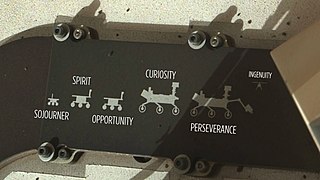
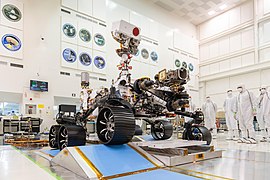
![Technischer Aufbau des Rovers – 3D-CAD-Modell[76]](http://upload.wikimedia.org/wikipedia/commons/thumb/c/c2/Computer-Design_Drawing_for_NASA%27s_2020_Mars_Rover.jpg/296px-Computer-Design_Drawing_for_NASA%27s_2020_Mars_Rover.jpg)






